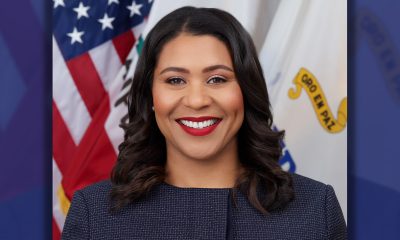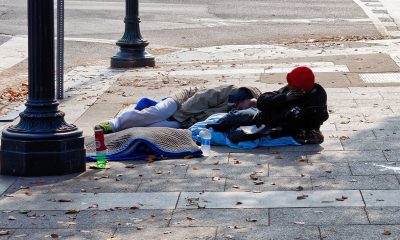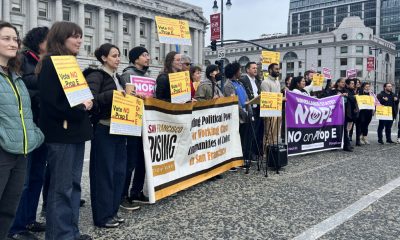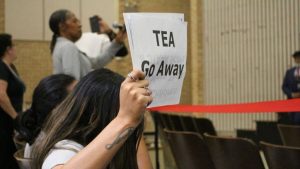Bay Area
Mayor London Breed Announces Mid-Market Vibrancy and Safety Plan
Increased police presence will combine with community ambassadors to cover every block of the area that stretches from U.N. Plaza to Powell Street
Mayor London N. Breed announced on Tuesday the Mid-Market Vibrancy and Safety Plan, which is aimed at creating a safer and more welcoming environment in the Mid-Market and Tenderloin area.
The plan includes both a visible increase in police presence to deter criminal activity and a community ambassador program to connect people in need with services, and provide a welcoming presence for residents, workers, visitors, and businesses.
Community-based safety ambassadors will be stationed on every block of the area from Powell Station (5th Street) to 8th Street on Market Street and adjacent areas just south of Market Street, UN Plaza, and the Tenderloin blocks bordered by Larkin Street and Eddy Street.
Both the law enforcement and community initiatives will work in tandem to address challenges in the area and coordinate appropriate responses. Funding for this program will be included in Breed’s upcoming budget proposal and will be supplemented by private funding. However, key aspects of this plan will begin immediately using existing funding. This program will also be supported by new State funding secured by UC Hastings.
“All of our residents and workers deserve to feel safe, and this area of the City continues to face a number of challenges that need to be addressed,” said Breed. “With this plan, we’re focusing on both addressing the illegal activity that is unacceptable and will not be allowed to continue, while also building up our community presence so that this area is more welcoming, friendly, and accessible to everyone who lives, works, and visits the area. This effort is really a collaboration with support and guidance from the community, especially the many families with children, workers, and senior communities that live and work here. This sustained, focused approach will make a noticeable difference on the street as our City reopens and we continue to move forward with our economic recovery.”
The plan for Mid-Market is to add additional City, private, and community resources so that law enforcement personnel and community ambassadors are visible and active in the area. It will be composed of two main efforts:
Community-Based Safety Ambassadors on Every Block
This initiative will support the Mid-Market/Tenderloin Community-Based Safety Program, a collaboration between the Mid-Market Business Association, Tenderloin, Mid-Market and Civic Center Community Benefit Districts (CBDs), Urban Alchemy, BART, SFMTA, San Francisco Public Works, and San Francisco Police Department (SFPD) to coordinate daily management of cleaning and safety services in the targeted Mid-Market area.
Every day, community ambassadors will be stationed on each block of the area for 10-12 hours per day, to engage with residents and visitors, support people in need and connect them with services, address safety issues, and support the cleanliness of the area.
These ambassadors, provided by Urban Alchemy, will work in coordination with other City initiatives, including the Healthy Streets Operation Center, the new Street Response Teams, and others to ensure the appropriate response for different situations that may arise. With existing funding, the program will launch June 15, 2021.
Increased Public Safety Presence
Beginning immediately, the SFPD will also increase deployments in the area, including foot patrols, motorcycle and bicycle deployments, and officers on horseback. They will focus on providing a visible presence in the Mid-Market, UN Plaza, and Tenderloin areas.
The strategy will embody multiple objectives outlined in the SFPD Community Policing Strategic Plan — a key element to emerge from the department’s Collaborative Reform Initiative to be a model of 21st century policing — enabling SFPD officers to collaboratively identify and develop responses to issues that affect local residents, businesses and visitors; to connect individuals in need to appropriate resources when services fall outside the scope of police work; and to increase the visible presence of officers though positive, trust-building engagements with the residents, businesses and visitors they’re sworn to safeguard.
In alignment with Mayor Breed’s focus on reimagining public safety, community policing will be the basis of the increased public safety investment in this area, emphasizing community partnerships and proactive problem-solving with mutual respect between the police and the people of San Francisco that they serve.
SFPD will operate this coordinated initiative from a UN Plaza location, where sister agencies and community-based partners will meet daily for updates and information sharing.
“San Francisco residents and businesses made enormous sacrifices over the past year to make our City’s COVID-19 response a nationally recognized success, and nowhere were those sacrifices greater than in our Tenderloin and Mid-Market neighborhoods,” said Chief of Police Bill Scott. “Mayor Breed’s Mid-Market Vibrancy and Safety Plan is another bold step that makes good on our shared civic commitment to come back even stronger than before. For all of us in the San Francisco Police Department, we’re grateful for this opportunity to showcase what community policing and 21st century police reform looklike.”
The police presence and the initial launch of the Community Ambassadors effort will be funded with existing City resources. To sustain the Community Ambassadors efforts for the longer-term, the mayor is proposing to provide $5 million in funding in her upcoming budget, while UC Hastings has dedicated $3 million in state funding. Working together in partnership with the mayor’s administration, UC Hastings has sought and received the support of Gov. Gavin Newsom, who has included in his May Revision budget proposal an allocation of $3 million over three years to fund Urban Alchemy’s services contiguous to its campus. This financial investment over a three-year period is a significant complement to this initiative.
The police deployment will begin Wednesday, May 19 and the Community Ambassadors will begin June 15 and ramp up to full coverage over the summer.
The community response has been positive, so far.
“Since mid-2020, the group Urban Alchemy has been patrolling the first block of Sixth Street and Market Street around that area,” said Dan Jordan, a Sixth Street resident. “I have found that it is safer to walk through the area because there are far less drug dealers and users out on the sidewalks and that these people stop those people from hassling other people.”
Max Young, owner of Mr. Smith’s
“Knowing that the area around my business will become safer for my customers will motivate me to start working on reopening” said Max Young, owner of Mr. Smith’s. “This makes a huge difference.”
San Francisco Mayor London Breed’s Office of Communications created this report.
Bay Area
East Bay Regional Park District Issues Rattlesnake Advisory
The East Bay Regional Park District released an advisory today on rattlesnakes, which emerge from winter hibernation in early spring and become more active. Warm weather can bring more potential for rattlesnake encounters with humans and dogs, particularly along trails and roads.
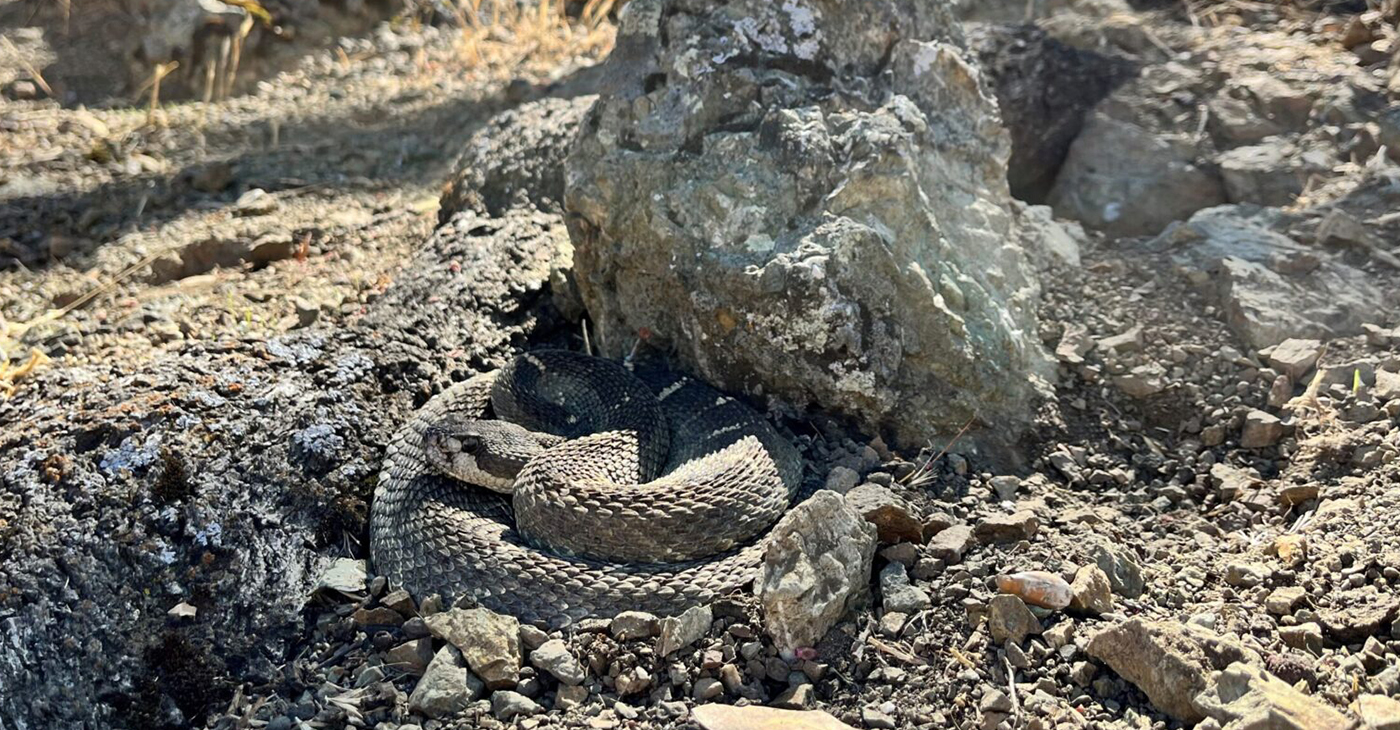
The Richmond Standard
The East Bay Regional Park District released an advisory today on rattlesnakes, which emerge from winter hibernation in early spring and become more active.
Warm weather can bring more potential for rattlesnake encounters with humans and dogs, particularly along trails and roads.
Visitors are encouraged to avoid hiking alone in case of an emergency, to scan the ground ahead as they walk, jog or ride, stay on trails avoiding tall grass, and to look carefully around and under logs and rocks before sitting down. Keep your dog on your leash to be extra safe, park officials said.
If you encounter a rattlesnake, leave it alone – it is unlawful to capture or harm one. Move carefully and slowly away or around it and give it plenty of space, park officials said.
Those who are bitten by a rattlesnake are instructed to stay calm by lying down with the affected limb lower than the heart, then having someone call 911.
Getting medical attention is critical.
Those bitten should not use tourniquets, “sucking,” or snake bite kits. If you are by yourself, walk calmly to the nearest source of help to dial 911, do not run.
If bitten by any other type of snake, wash the wound with soap and water or an antiseptic and seek medical attention.
Not sure what bit you? Check the bite for two puncture marks (in rare cases one) associated with intense, burning pain, which is typical of a rattlesnake bite. Other snakebites can leave marks without associated burning pain.
The Northern Pacific rattlesnake is the species found in East Bay Regional Parks. Snakes are important to the natural environment, helping to control rodents and other reptile populations. But enjoy them from afar.
For more information, download the Park District’s Common Snakes brochure or watch our Gopher Snake or Rattlesnake video to learn how to tell the difference between rattlesnakes and gopher snakes. Additional information is available at ebparks.org/safety/wildlife-encounters.
Bay Area
Mayor Breed Proposes Waiving City Fees for Night Markets, Block Parties, Farmers’ Markets, Other Outdoor Community Events
Mayor London N. Breed introduced legislation on April 26 to encourage and expand outdoor community events. The first will waive City fees for certain events, making them less costly to produce. The second will simplify the health permitting for special event food vendors through the creation of an annual permit. Both pieces of legislation are part of the Mayor’s broader initiative to bring vibrancy and entertainment to San Francisco’s public right of ways and spaces.

Mayor’s Press Office
Mayor London N. Breed introduced legislation on April 26 to encourage and expand outdoor community events.
The first will waive City fees for certain events, making them less costly to produce. The second will simplify the health permitting for special event food vendors through the creation of an annual permit. Both pieces of legislation are part of the Mayor’s broader initiative to bring vibrancy and entertainment to San Francisco’s public right of ways and spaces.
Outdoor community events are integral to San Francisco’s vibrant culture and sense of community. These events include night markets, neighborhood block parties and farmers markets, and bolster the City’s economy by supporting local businesses and attracting tourists eager to experience San Francisco’s unique charm and food scene.
They offer residents, workers and visitors, opportunities to engage with local artists, musicians, and food vendors while enjoying the San Francisco’s stunning outdoor spaces and commercial corridors.
The legislation will allow for more and new community gatherings and for local food vendors to benefit from the City’s revitalization.
“San Francisco is alive when our streets are filled with festivals, markets, and community events,” said Breed. “As a city we can cut fees and streamline rules so our communities can bring joy and excitement into our streets and help revitalize San Francisco.”
Fee Waiver Legislation
The events that can take advantage of the new fee waivers are those that are free and open to the public, occupy three or fewer city blocks, take place between 8 a.m. and 10 p.m., and have the appropriate permitting from the ISCOTT and the Entertainment Commission.
The applicant must be a San Francisco based non-profit, small business, Community Benefit District, Business Improvement District, or a neighborhood or merchant association. Fees eligible for waiver include any application, permit, and inspection/staffing fees from San Francisco Municipal Transportation Agency, Department of Public Health, Fire Department, Entertainment Commission, and Police Department.
Currently, it can cost roughly anywhere between $500-$10,000 to obtain permits for organized events or fairs, depending on its size and scope. Organizations and businesses are limited to a maximum of 12 events in one calendar year for which they can receive these fee waivers.
Food Vendor Streamlining Legislation
The second piece of legislation introduced will help special event food vendors easily participate in multiple events throughout the year with a new, cost-effective annual food permit. Food vendors who participate in multiple events at multiple locations throughout the year will no longer need to obtain a separate permit for each event. Instead, special event food vendors will be able to apply and pay for a single annual permit all at once.
“Many successful food businesses either begin as pop-up vendors or participate in special events to grow their business,” says Katy Tang, Director of the Office of Small Business. “Giving them the option for an annual special event food permit saves them time and money.”
Currently, food vendors are required to get a Temporary Food Facility (TFF) permit from the Department of Public Health (DPH) in order to participate in a special event, among permits from other departments.
Currently, each special event requires a new permit from DPH ranging from $124-$244, depending on the type of food being prepared and sold. Last year, DPH issued over 1,500 individual TFF permits. With the new annual permit, food vendors selling at more than four to six events each year will benefit from hundreds of dollars in savings and time saved from fewer bureaucratic processes.
“This legislation is a step in the right direction to make it easier for food vendors like me to participate in citywide events,” said Dontaye Ball, owner of Gumbo Social. “It saves on time, money and makes it more effective. It also creates a level of equity.”
Bay Area
Faces Around the Bay: Sidney Carey
Sidney Carey was born in Dallas, Texas. He moved with his family to West Oakland as a baby. His sister is deceased; one brother lives in Oakland. Carey was the Choir Director at Trinity Missionary Baptist Church for 18 years.
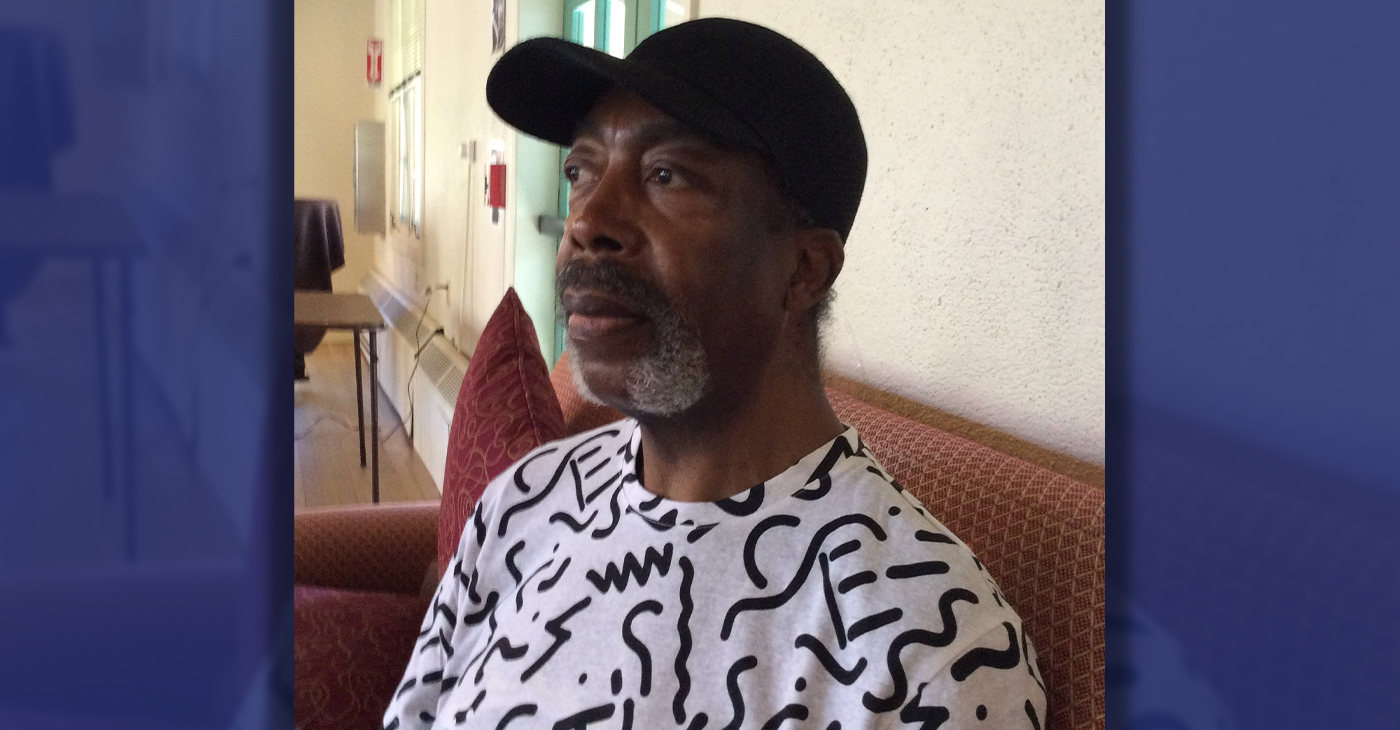
By Barbara Fluhrer
Sidney Carey was born in Dallas, Texas. He moved with his family to West Oakland as a baby. His sister is deceased; one brother lives in Oakland.
Carey was the Choir Director at Trinity Missionary Baptist Church for 18 years.
He graduated from McClymonds High with a scholarship in cosmetology and was the first African American to complete a nine-month course at the first Black Beauty School in Oakland: Charm Beauty College.
He earned his License, and then attended U.C., earning a secondary teaching credential. With his Instructors License, he went on to teach at Laney College, San Mateo College, Skyline and Universal Beauty College in Pinole, among others.
Carey was the first African American hair stylist at Joseph and I. Magnin department store in Oakland and in San Francisco, where he managed the hair stylist department, Shear Heaven.
In 2009, he quit teaching and was diagnosed with Congestive Heart Failure. He was 60 and “too old for a heart transplant”. His doctors at California Pacific Medical Center (CPMC) went to court and fought successfully for his right to receive a transplant. One day, he received a call from CPMC, “Be here in one hour.” He underwent a transplant with a heart from a 25-year- old man in Vienna, Austria
Two years later, Carey resumed teaching at Laney College, finally retiring in 2012.
Now, he’s slowed down and comfortable in a Senior Residence in Berkeley, but still manages to fit his 6/4” frame in his 2002 Toyota and drive to family gatherings in Oakland and San Leandro and an occasional Four Seasons Arts concert.
He does his own shopping and cooking and uses Para Transit to keep constant doctor appointments while keeping up with anti-rejection meds. He often travels with doctors as a model of a successful heart-transplant plant recipient: 14 years.
Carey says, “I’m blessed” and, to the youth, “Don’t give up on your dreams!”
-

 Community2 weeks ago
Community2 weeks agoFinancial Assistance Bill for Descendants of Enslaved Persons to Help Them Purchase, Own, or Maintain a Home
-

 Activism4 weeks ago
Activism4 weeks agoOakland Post: Week of April 3 – 6, 2024
-

 Business3 weeks ago
Business3 weeks agoV.P. Kamala Harris: Americans With Criminal Records Will Soon Be Eligible for SBA Loans
-

 Activism3 weeks ago
Activism3 weeks agoOakland Post: Week of April 10 – 16, 2024
-

 Community3 weeks ago
Community3 weeks agoAG Bonta Says Oakland School Leaders Should Comply with State Laws to Avoid ‘Disparate Harm’ When Closing or Merging Schools
-

 Community2 weeks ago
Community2 weeks agoOakland WNBA Player to be Inducted Into Hall of Fame
-

 Community2 weeks ago
Community2 weeks agoRichmond Nonprofit Helps Ex-Felons Get Back on Their Feet
-

 Community2 weeks ago
Community2 weeks agoRPAL to Rename Technology Center for Retired Police Captain Arthur Lee Johnson



